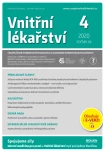Anticoagulation therapy in cancer associated thromboembolism – new studies, new guidelines
Authors:
Jana Hirmerová
Authors‘ workplace:
II. interní klinka FN Plzeň
Published in:
Vnitř Lék 2020; 66(4): 225-231
Category:
Overview
Low molecular weight heparin (LMWH) has become a standard of treatment of cancer-associated thromboembolism (CAT). Until recently, direct oral anticoagulants (DOAC) have not had data about efficacy and safety in cancer patients. However, in the last two years, four randomized open-label studies comparing DOAC and LMWH in the treatment of CAT have been published. The first one was a large trial with edoxaban, followed by two smaller studies with rivaroxaban and apixaban, and, recently, by another large trial with apixaban. There are some differences among the studies concerning design, inclusion and exclusion criteria, length of treatment. In summary, DOAC are associated with a trend to the reduction of the risk of recurrence of venous thromboembolism; however, this is at the expense of some increase in bleeding risk. This risk is differential; the prevailing site of bleeding is the upper part of gastrointestinal tract, and, to a lesser extent, genitourinary tract. The updated guidelines for the treatment of CAT suggest DOAC as an alternative, however with careful consideration of the risk of bleeding and the risk of drug interactions. So far, the guidelines have mentioned edoxaban and rivaroxaban. With emerging evidence, apixaban is expected to play a role as well.
Keywords:
Venous thromboembolism – cancer – anticoagulation – low molecular weight heparin – direct oral anticoagulants
Sources
1. Prandoni P, Lensing AW, Piccioli, et al. Recurrent venous thromboembolism and bleeding complications during anticoagulant treatment in patients with cancer and venous thrombosis. Blood 2002; 100 (10): 3484–3488.
2. Kearon C, Kahn SR, Agnelli G, et al. Antithrombotic therapy for venous thomboembolic disease: American College of Chest Physicians Evidence‑Based Clinical Practice Guidelines (8th Edition). Chest. 2008 Jun; 133(6 Suppl): 454S–545S.
3. Lee AY, Peterson EA. Treatment of cancer‑associated thrombosis. Blood. 2013; 122(14): 2310–2317
4. Kearon C, Akl EA, Omelas J, et al.Antithrombotic Therapy for VTE Disease: CHEST Guideline and Expert Panel Report. Chest 2016; 149 : 315–352.
5. Noble SI, Finlay IG. Is long‑term low‑molecular‑weight heparin acceptable to palliative care patients in the treatment of cancer related venous thromboembolism? A qualitative study. Palliat Med. 2005; 19(3): 197–201.
6. van der Wall SJ, Klok FA, den Exter PL, Barrios D, Morillo R, Cannegieter SC, et al. Continuation of low‑molecular‑weight heparin treatment for cancer‑related venous thromboembolism: a prospective cohort study in daily clinical practice. J Thromb Haemost. 2017; 15(1): 74–79.
7. Raskob GE, van Es N, Verhamme P, Carrier M, Di Nisio M, Garcia D, et al. Edoxaban for the Treatment of Cancer‑Associated Venous Thromboembolism. N Engl J Med. 2018; 378(7): 615–624.
8. Mulder FI, van Es N, Kraaijpoel N, et al. Edoxaban for treatment of venous thromboem ‑ bolism in patient groups with different types of cancer: Results from the Hokusai VTE Cancer study. Thromb Res. 2020; 185 : 13–19.
9. Di Nisio M, van Es N, Carrier M, et al. Extended treatment with edoxaban in cancer patients with venous thromboembolism: A post‑hoc analysis of the Hokusai‑VTE Cancer study. J Thromb Haemost. 2019; 17(11): 1866–1874.
10. Young AM, Marshall A, Thirlwall J, et al. Comparison of an Oral Factor Xa Inhibitor With Low Molecular Weight Heparin in Patients With Cancer With Venous Thromboembolism: Results of a Randomized Trial (SELECT‑D). J Clin Oncol. 2018; 36(20): 2017–2023.
11. Marshall A, Levine M, Hill C, et al.Treatment of cancer‑associated venous thromboembolism: 12-month outcomes of the placebo versus rivaroxaban randomization of the SELECT‑D Trial (SELECT‑D: 12 m). J Thromb Haemost. 2020; 18(4): 905–915.
12. McBane RD 2nd, Wysokinski WE, Le‑Rademacher JG, et al. Apixaban and dalteparin in active malignancy‑associated venous thromboembolism: The ADAM VTE trial. J Thromb Haemost. 2020; 18(2): 411–421.
13. Agnelli G, Becattini C, Meyer G. Apixaban for the Treatment of Venous Thromboembolism Associated with Cancer. N Engl J Med. 2020; 23; 382(17): 1599–1607.
14. Khorana AA, Noble S, Lee AYY, et al. Role of direct oral anticoagulants in the treatment of cancer‑associated venous thromboembolism: guidance from the SSC of the ISTH. J Thromb Haemost 2018; 16(9): 1891–1894.
15. Key NS, Khorana AA, Kuderer NM, et al. Venous Thromboembolism Prophylaxis and Treatment in Patients With Cancer: ASCO Clinical Practice Guideline Update. J Clin Oncol. 2020; 38(5): 496–520.
16. Farge D, Frere C, Connors JM, et al. 2019 international clinical practice guidelines for the treatment and prophylaxis of venous thromboembolism in patients with cancer. Lancet Oncol. 2019; 20(10): e566–e581.
17. Moik F, Pabinger I, Ay C. How I treat cancer‑associated thrombosis. ESMO Open. 2020;5(1):e000610. doi:10.1136/esmoopen-2019-000610.
Labels
Diabetology Endocrinology Internal medicineArticle was published in
Internal Medicine

2020 Issue 4
Most read in this issue
- Liver fibrosis
- Evaluation of surgical risk in patients with liver cirrhosis
- Microscopic polyangiitis
- Hyperuricemia in renal disease patients
